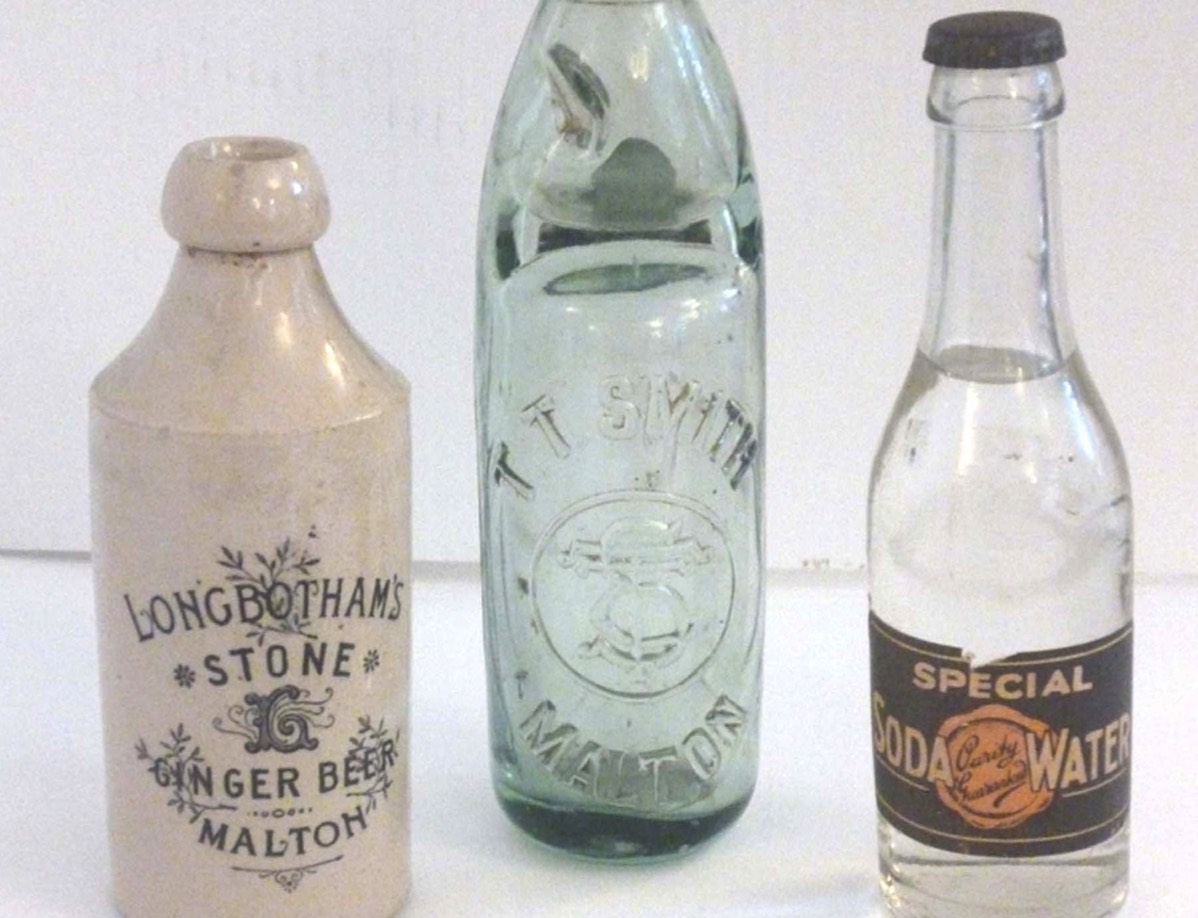
Here you will find information centred on specific items in the Woodhams Stone Collection (for example the Medicine Cabinet featured below), themes running through the collection which unite a number of items (for example Breweries) or information about businesses which have been prominent in Malton or Norton and the people behind them.
Much of this information has been researched to support exhibitions we have run in recent years. We give a flavour of the subject below but more detail is avaiable in a downloadable document, a link to which appears at the bottom of each article.
Paper Pattern by Mme. Demorest
Madame Demorest was born Ellen Louise Curtis in 1824. Her father owned a hat factory and she initially opened a millinery shop. After moving her business to New York she met and married William Jennings Demorest, a widower, who had recently opened Madame Demorest’s Emporium of Fashion on Broadway. She developed many fashion related innovations including her own drafting system, but it was her mass-production and promotion of paper patterns that single her out in the history of fashion.
Madame Demorest offered single paper patterns for bodices, sleeves, children’s clothing, underwear and outerwear in plain or trimmed. Complete patterns were also sold and were available through shops, dressmaker’s establishments or mail order. The patterns were all one size only and came with very few instructions. They had to be adapted by the maker to fit the wearer, although Madame Demorest offered custom made patterns on receipt of the relevant body measurements. Find out more.

Corkscrew & Champagne Tap
As bottles moved from being hand blown individually to being moulded in large numbers, they became more uniform in shape and size. They became more cylindrical and could be stored on their sides. Corks, therefore, had to fit tighter, and were compressed before being inserted into the bottle neck. As a result they were more difficult to remove. The ‘bottle screw’, as the corkscrew were first known, appeared in England in the 1600s. It was almost certainly modelled on the ‘worm’ or ‘screw’, an implement used for cleaning gun barrels. Find out more

Medicine Cabinet
This large medicine cabinet has recently been added to the Woodhams-Stone Collection. While its exact history is not known, it appears to have retained most of its original contents. It has also had some wonderful extra items added to it including an enema kit and a glass nipple shield. It probably dates to about 1900. Find out more.

Portable Gramophone
The gramophone in the Woodhams Stone Collection is an HMV Model 102. This was a popular portable model produced between 1931 to 1958. This machine dates from the 1930s and the case is covered in a very fashionable green. It also boasts an additional record holder with raised sides which fits over the turntable. This was used to transport records safely and lifts off the turntable when the gramophone was in use. It strangely does not look so old fashioned. 3.2 million vinyl records were sold in 2016 a rise of 53% on the previous year and vintage style record players have been popular for a few years now. I suspect that these new gramophones are not hand-cranked like our original. Find out more

Shaving
Throughout history both men and women have removed unwanted body hair, and razor like objects have been found dating back to the Bronze Age. The first recorded folding ‘cut throat’ razor was listed in Sheffield in 1680. The type of edge that a razor was given varied and they could be quite specialised. One of the cut throat razors in the Woodhams Stone Collection is marked ‘Hollow Ground’ meaning that the sides of the blade are concave. These were the type of razors usually preferred by barbers. Cut throat razors required skill to use and the blade had to be extremely sharp and held at just the correct angle to the face to avoid injury. Find out more

Typhoid Outbreak 1932
It is easy to think of typhoid as a problem which affects only developing countries, but not long ago typhoid epidemics were endemic in Britain. Indeed Malton experienced a serious outbreak as late as 1932. A large framed map in the Woodhams Stone Collection records the epidemic. It pin points the position of the sewers, drains and water mains as well as the houses where those affected lived – each marked with a red cross. It is believed to have been created in 1933 for the Ministry of Health’s Report and covers houses in Malton, Norton and Old Malton. Find out more

Brewing Industry
Brewing has been an important part of life in Malton for generations. Both the main breweries, Russells and Rose’s, met their ends with mergers and buy outs in the mid to late 20th century. Vivid memories remain of the brewery buildings on Castlegate. Find out more

Pop!
Aerated water and carbonated drinks were made in Malton and Norton in Victorian times by a number of manufacturers. It was originally thought that carbonated drinks had medicinal benefit and so early involvement in this business included chemists in the towns. Do you know a ‘Codd’ bottle from a ‘Hamilton’ bottle? Find out more

Ceramic Water Filter
This water filter in the Woodhams Stone Collection is typical of those used in the late 19th century. It was manufactured by T. Elliott and Company in Manchester, a city where there were great problems with the provision of a clean water supply. It is made of brown salt glazed stoneware and the body of the filter is decorated with sprigging showing baskets of flowers and other foliate motifs. The filter itself was made of activated charcoal, or, as the company put it, it was a “Self Cleansing Carbon Filter”. Carbon absorbs the impurities present in water making it much safer to drink. Carbon filters are still used in water filters today. Find out more

Horse Hoof Inkwell
Many museum collections include examples of antique taxidermy. Not to modern taste, they often divide opinion and are problematic to display. The inkwell in the Woodhams Stone Collection, however, has a happier story than most examples of taxidermy. The horse, named Malton, carried Lord Grimthorpe during the First World War, 1915-1917. Lord Grimthorpe went on to breed race horses, and later thoroughbreds, at his Eastthorpe Hall stud. He was also joint Master of the Middleton Hunt from 1921. Find out more

Sewing Machine - Wilcox & Gibbs
Today the sewing machine is a firmly established piece of equipment both in the work place and the home. Traditionally women were expected to clothe themselves and their family and provide all the household textiles. If they were unable to employ a professional tailor or seamstress, then they stitched everything themselves – by hand. No wonder then when the first practical and affordable sewing machines appeared on the market women took to them almost immediately. Sewing machines were truly time and labour saving. Find out more

Longster & Sons
Longster’s was a business that was truly built from the ground up. The founder of the firm was William Longster. He is described in an 1823 trade directory as a gardener, nursery and seedsman. It is said that he began with four acres of land on the banks of the River Derwent. This land consisted of heavy clay soil and was very difficult to work. Some stories say that often when the ground needed digging the spade had to be dipped into a bucket of water first. It is also claimed that William spread several hundred loads of road sweepings on the land in an effort to improve the condition of the soil. It clearly worked; the business grew and a small shop was opened on Old Maltongate. Find out more

Holloway's Ointment Pot
This little object – less than four centimetres tall – is an ointment pot which once contained the world famous Holloway’s Ointment. The transfer print on the pot depicts Hygieia, the Greek goddess of hygiene and cleanliness, seated with her brother Telesphoros, the god of convalescence. He carries a sign which says “Never Despair”. On her other side is the single snake from the staff belonging to her father, Asclepius, the Greek god of healing. Holloway’s initials TM are embossed in the bottom of the inside of the pot.
Holloway’s ointment made enormous claims. Our little pot claims to cure gout and rheumatism, inveterate ulcers, sore breasts, sore heads and bad legs. However, this is quite modest as in advertisements Holloway’s ointment and pills also claimed to cure burns, cancers, fistulas, glandular swellings, lumbago, piles, sore throats, scurvy, tumours, cuts and wounds as well as chest problems, skin diseases, snake bite, depression, children’s ailments, “youthful indulgences” and “all the maladies to which females are liable”. Analysis of the ointment seems to indicate that the ingredients were unlikely to actively cure anything, but they caused no harm – unlike some other popular quack medicines of the time. Find out more


Contact Us
Contact us by email
The Woodhams Stone Collection is a Registered Charity No: 1177312
Our address:
Malton & Norton Heritage Centre
2 Buckrose Court
Commercial Street
Norton YO17 9HN
The Malton and Norton Heritage Centre is currently closed to visitors. If you have a research related enquiry please use our email address.

Please Donate
The Woodhams Stone Collection is entirely run by volunteers and is housed in the Malton & Norton Heritage Centre. A donation however small would help towards our running costs and the purchase of archive quality materials required to store and preserve the Collection for future generations. If you should decide to donate via the PayPal button neither you nor Woodhams Stone Collection will be charged a fee for this donation.
At the end of the transaction you will be asked if you wish the payment to be made as part of the GiftAid scheme. If you are a UK taxpayer and able to do this it means that Woodhams Stone Collection can benefit by an additional 25% of your donation.


Malton & Norton Memories
This group is for those who are interested in life as it used to be in the twin towns of Malton and Norton. It is chiefly a showcase for photos and items from the Woodhams-Stone Collection but you are welcome to post any comments, memories or photos you may have to share.

